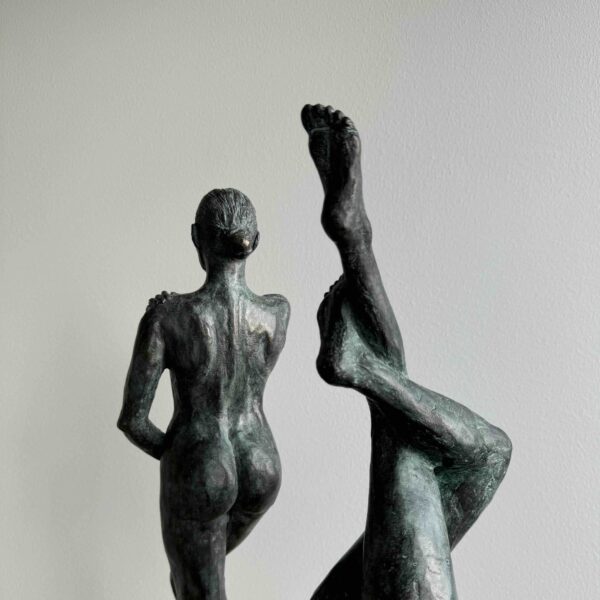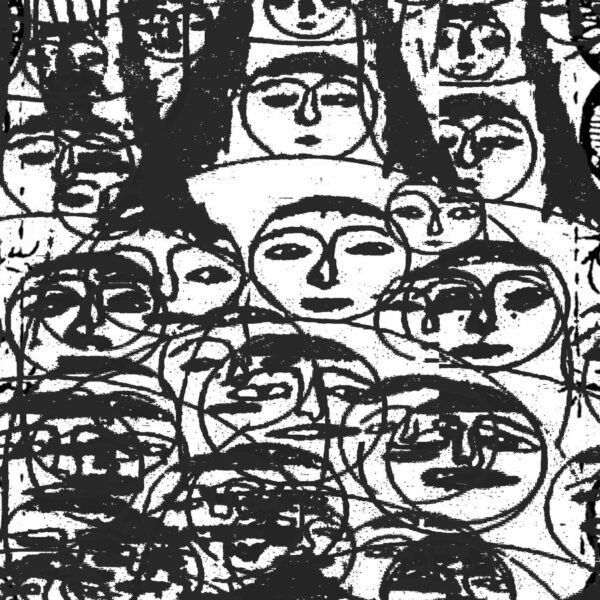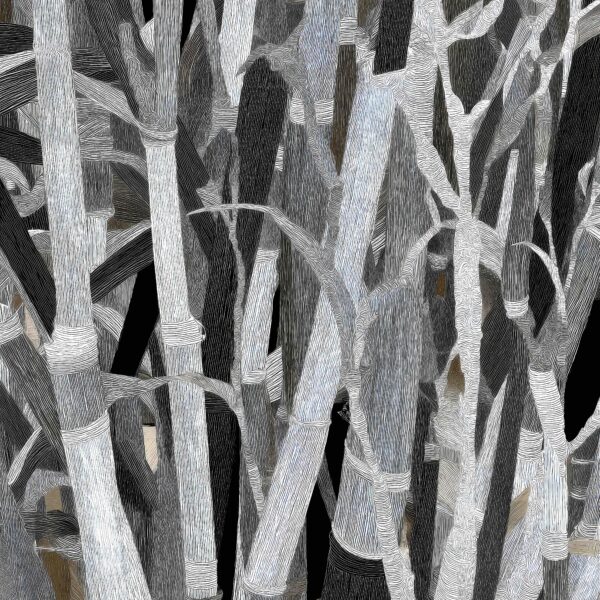The Evolution of Memetic Art: Pepenardo and the Legacy of Rare Pepes
This critique explores the innovative practice of Pepenardo, an artist who blends classical art history with contemporary meme culture. By examining key works such as "COMPUTER DEATH," "Untitled (#18833)," "ORANGETIMES," "FREEDOMWAR," and "SMUGTRUMP," this article explores the historical and theoretical contexts that inform his art. It highlights how Pepenardo's creations comment on technological self-entrapment, digital transcendence, and the evolving role of internet memetics in contemporary art.
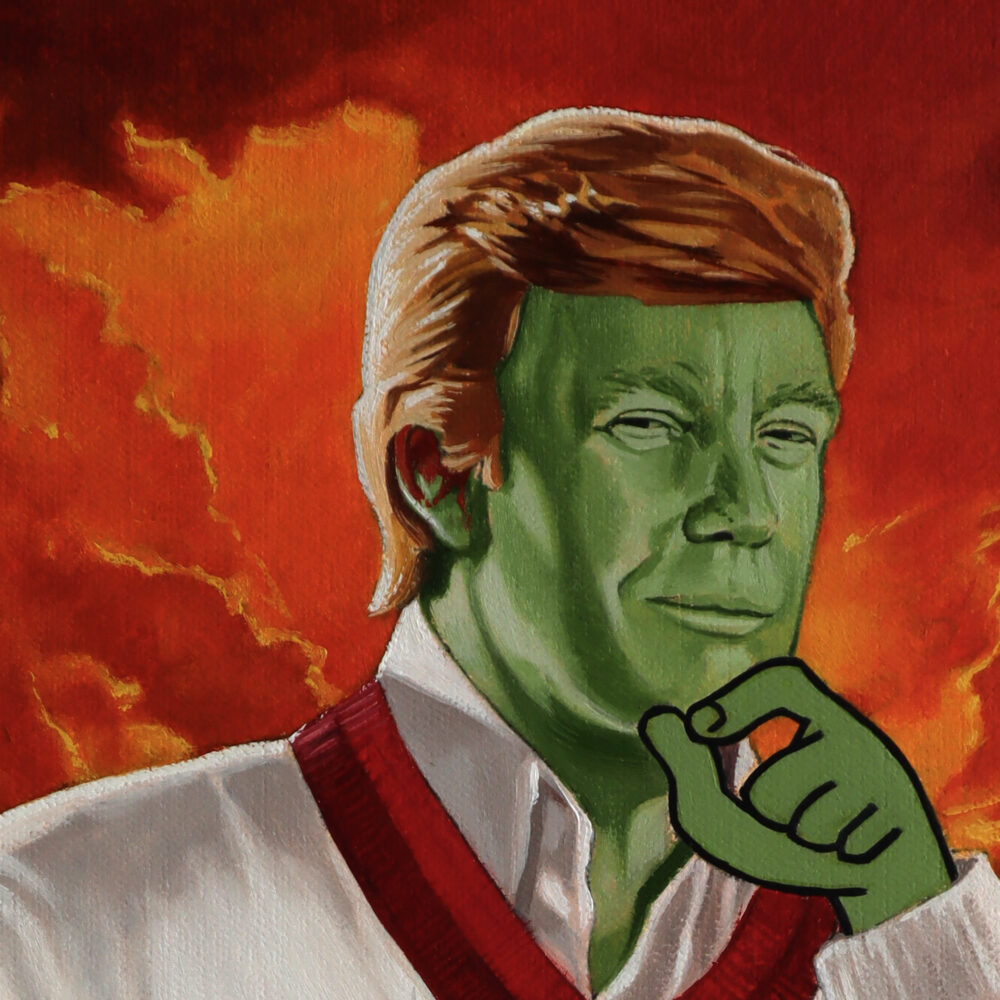
Pepenardo’s journey into the world of digital art is a fascinating narrative of adaptation and innovation. Initially an outsider to the Rare Pepe community, Pepenardo’s integration into the Fake Rares movement and his distinctive artistic style mark him as a significant figure in contemporary digital art. This critique aims to provide an insightful examination of Pepenardo’s practice, exploring his work within a broader historical and theoretical context.

Pepenardo’s Artistic Practice
Pepenardo’s art is a vivid amalgamation of classical art history and contemporary meme culture. His pieces, such as “FAKEPEPELISA,” “FAKEGENESIS,” “ORANGETIMES,” “FREEDOMWAR,” and “SMUGTRUMP,” reimagine iconic artworks and historical moments by embedding Pepe the Frog into these contexts. This approach not only pays homage to the originals but also creates a dialogue between the past and present, blending the timeless with the contemporary
His technique of hand-painting Pepe memes in oil is particularly noteworthy. The labor-intensive process of traditional oil painting contrasts sharply with the rapid, often lo-fi aesthetic of early Rare Pepes. This juxtaposition highlights a unique tension in his work, emphasizing the dichotomy between high art and low culture. Pepenardo’s ability to traverse these realms speaks to a broader cultural moment where the boundaries of art are continually being redefined. The meticulous craftsmanship of his paintings adds a layer of seriousness and permanence to the otherwise ephemeral nature of memes, suggesting that these digital artifacts deserve a place in the annals of art history.
Pepenardo, also known as Nardo, seeks to define the role of internet memetics within contemporary art. His works, which combine classical applications and digital language, explore themes of appropriation, metaphysics, and folklore. By mining images from the internet, mass media, and art history, Pepenardo creates both physical oil paintings and digitally manipulated works that reflect his view of viral internet memetics as a form of digital transcendence and elevation from nothingness. This perspective positions crypto artists as cypher-alchemists who become what they meme.
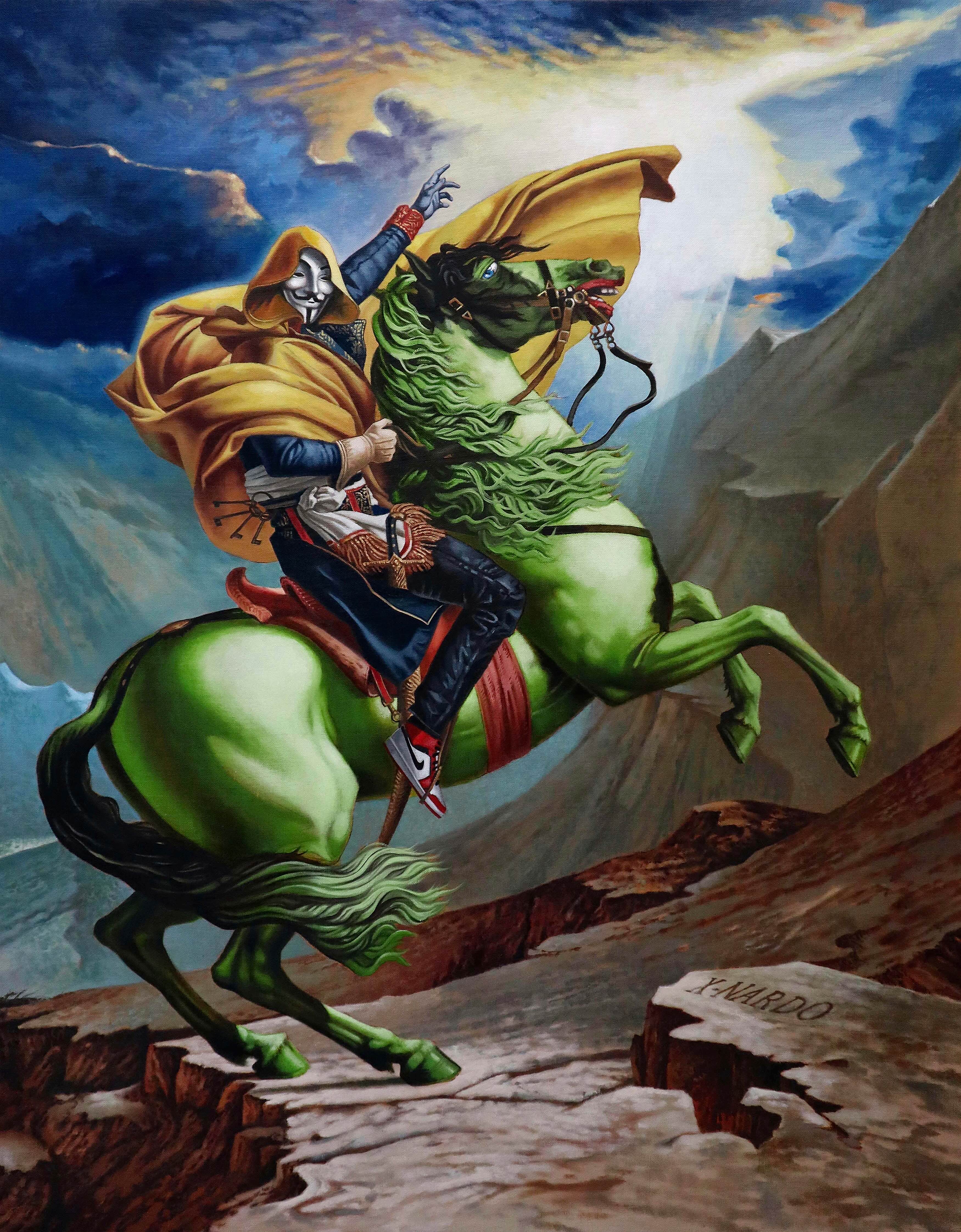
Technological Self-Entrapment and Artistic Reflection
Pepenardo’s “COMPUTER DEATH” reinterprets Andy Warhol’s “Electric Chair” series to comment on technological self-entrapment. The oil painting replaces the electric chair with a fictional computer death chair, symbolizing the slow decay of human flesh and spirit in the digital age. This piece critiques the dehumanizing effects of technology, a central concern of the Cypherpunk movement.
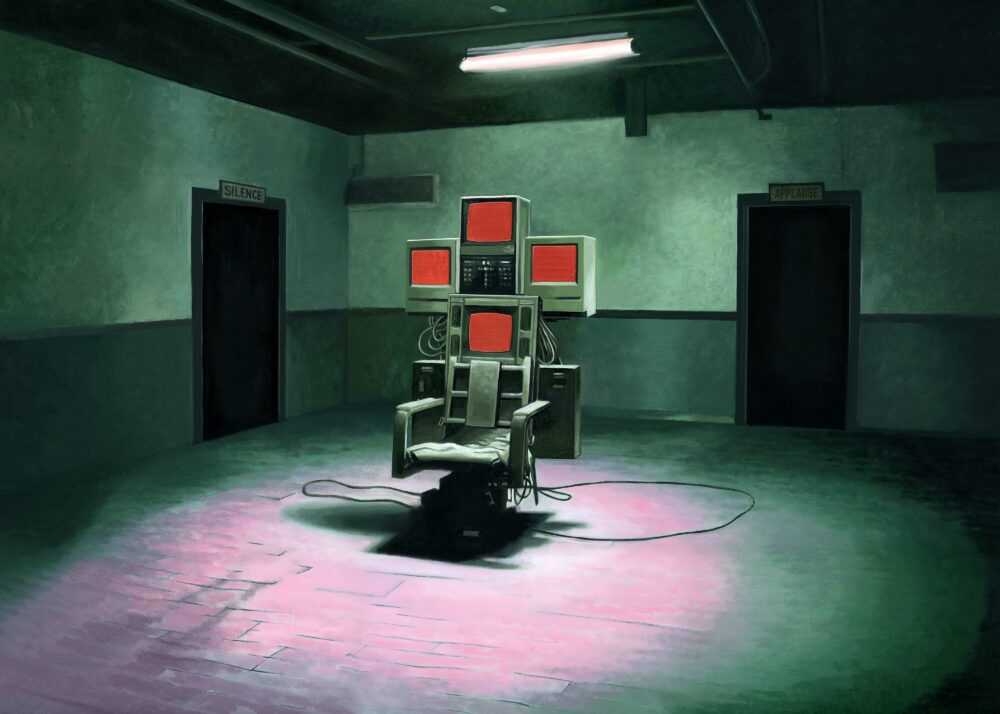
The painting features a dimly lit room with an eerie, greenish hue, reminiscent of an old, industrial facility. The central focus is a disturbing contraption that blends elements of an electric chair and a computer workstation. Multiple vintage computer monitors with red screens surround the chair, and wires snake around it, creating a sense of entrapment. The floor beneath the chair is illuminated with a soft, pinkish light, contrasting with the cold, green ambiance of the room. Two doors are visible on the walls, one labeled “Silence” and the other “Applause,” adding to the tense atmosphere and evoking a sense of unease and technological decay.
Pepenardo’s use of color and lighting is significant. The greenish hue of the room, combined with the red screens, creates a jarring, almost nauseating effect that underscores the discomfort and anxiety associated with technological overreach. The pinkish light beneath the chair adds an unsettling warmth, suggesting the human cost of this entrapment.
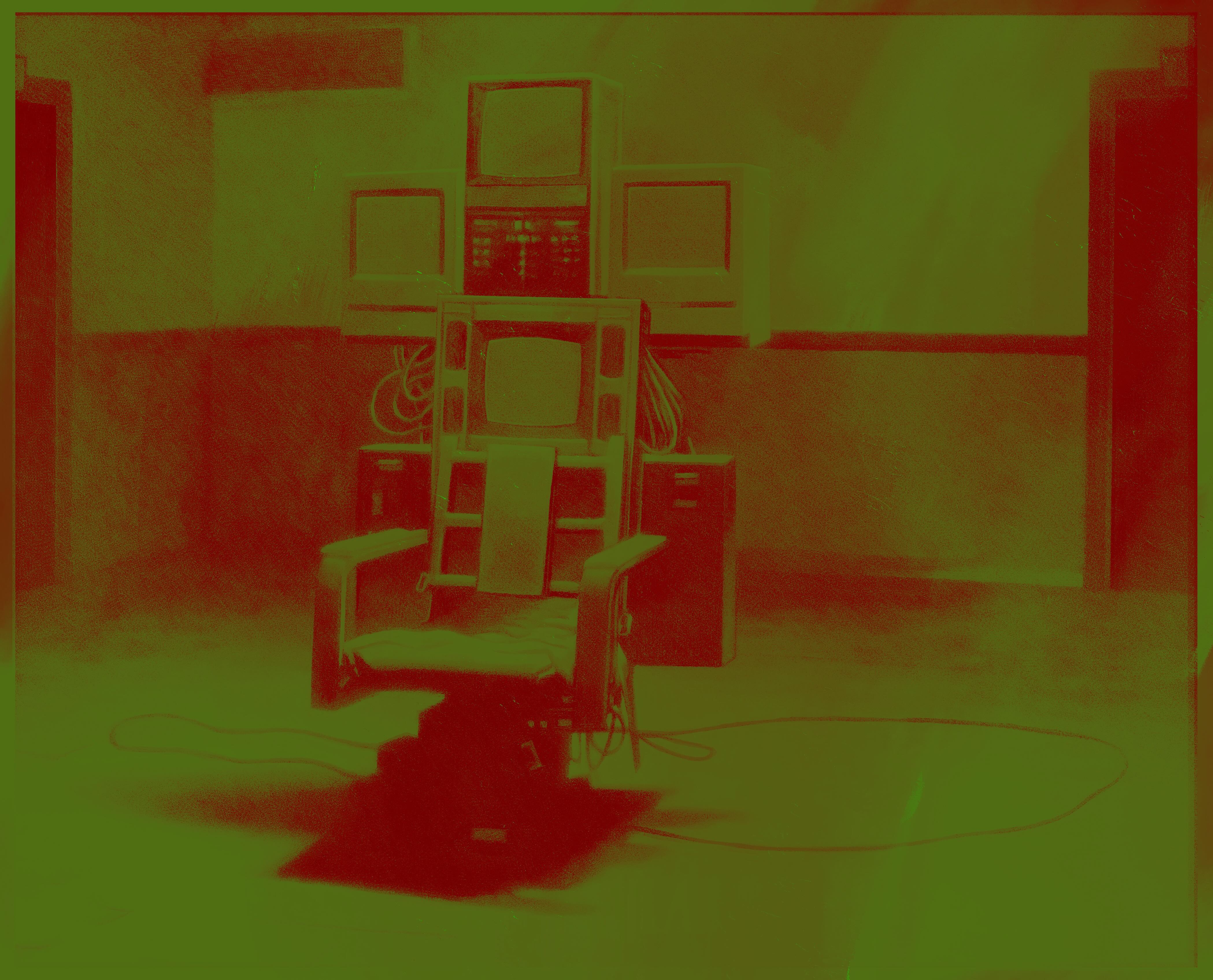
Historical Comparisons and Influences
Pepenardo’s work can be contextualized within a lineage of artists who have reinterpreted historical themes to comment on contemporary issues. For instance, his method recalls the works of the Dadaists, who repurposed existing images and objects to challenge traditional notions of art. Marcel Duchamp’s “L.H.O.O.Q.,” a defaced postcard of the Mona Lisa, serves as a clear precursor to Pepenardo’s memetic reinterpretations. Duchamp’s alteration of the Mona Lisa with a mustache and goatee was a provocative act intended to subvert the sanctity of the original and critique the art establishment. Similarly, Pepenardo’s “Untitled (#18833)” disrupts the viewer’s expectations and questions the hierarchical distinctions between high art and popular culture. By transforming da Vinci’s Mona Lisa into a green-skinned figure with the distinct features of the internet meme Guy Fawkes, Pepenardo bridges classical art and contemporary digital symbolism, creating a layered commentary on identity and rebellion in the digital age.
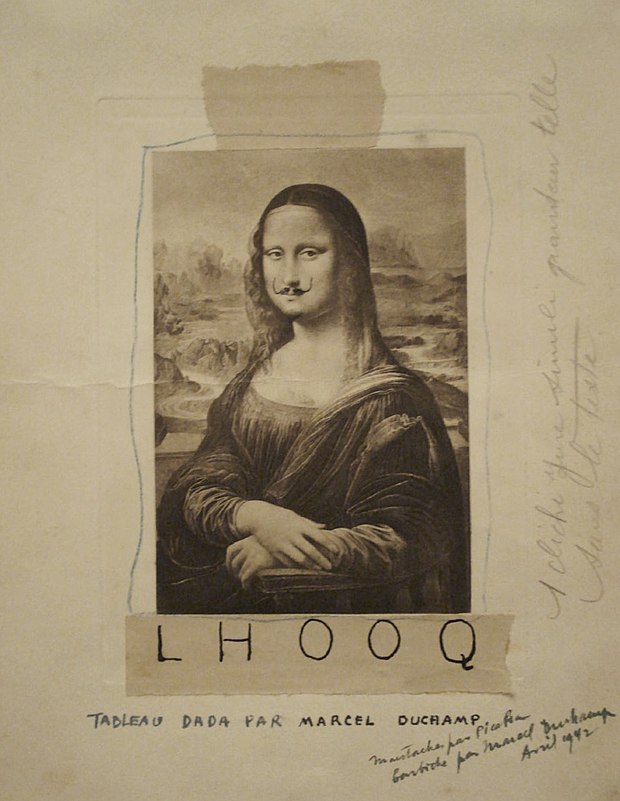
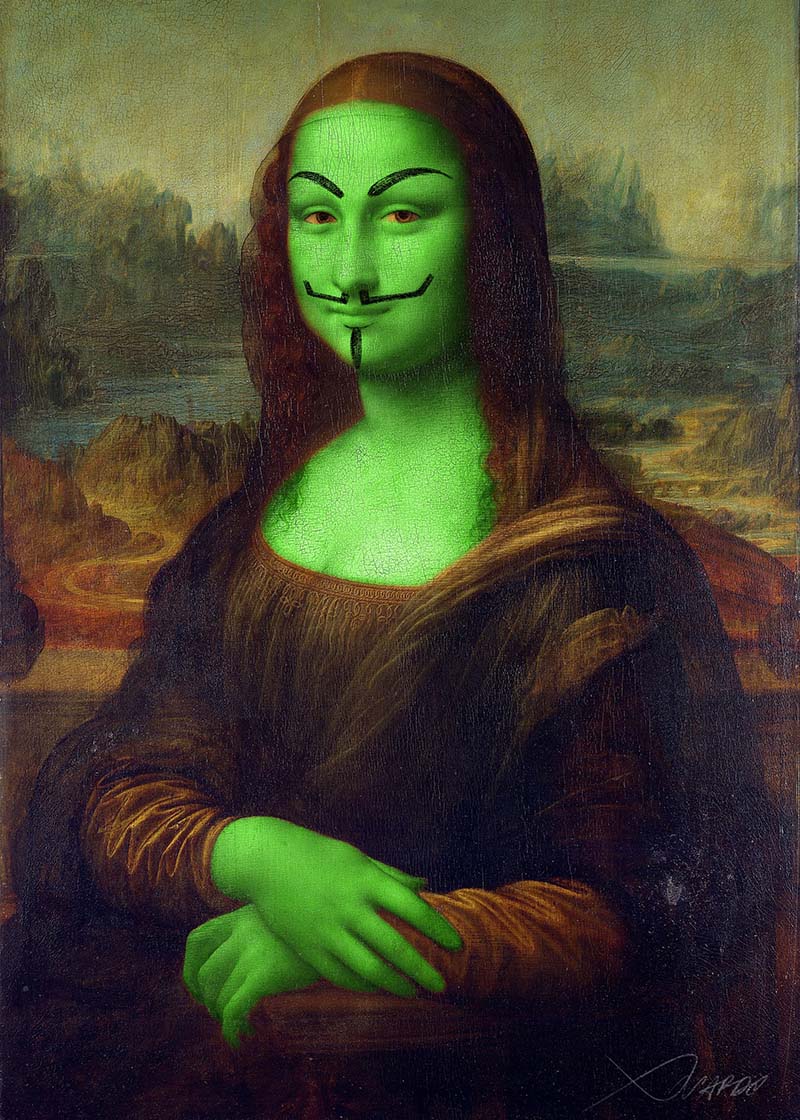
Analysis of “Untitled (#18833)”
“Untitled (#18833)” is a striking example of Pepenardo’s ability to blend classical art with modern meme culture. The painting reimagines Leonardo da Vinci’s Mona Lisa, a cornerstone of art history, by transforming her into a green-skinned figure with the iconic features of the Guy Fawkes mask, popularized by the film “V for Vendetta” and subsequently adopted by the hacktivist group Anonymous. The vibrant green skin and the stylized mustache and goatee of the mask juxtapose sharply with the Renaissance-era portrait, creating a visual and conceptual dissonance that invites viewers to reconsider the significance of both the original and the meme.
This work echoes Marcel Duchamp’s “L.H.O.O.Q.” in its subversive approach. Just as Duchamp added a mustache to the Mona Lisa to challenge the traditional art world and provoke thought, Pepenardo uses the Guy Fawkes mask to comment on the contemporary digital landscape. The mask, a symbol of anonymity, protest, and resistance, contrasts with the historically recognized and revered visage of the Mona Lisa, suggesting a critique of the current socio-political climate and the role of the individual within it.

Analysis of “ORANGETIMES”
“ORANGETIMES” by Pepenardo is a conceptual work that appropriates the main image sourced from the front page of the “Satoshi Times,” a publication symbolically heralding the emergence of Bitcoin. Although the imagery is unrelated to the main title article, “Chancellor on the Brink of Second Bailout for Banks,” the piece challenges viewers to consider historical events occurring alongside the creation of the genesis block on January 3, 2009. The monochromatic use of a bold orange background and the mysterious, almost cryptic imagery create a sense of intrigue, provoking reflection on the potential for technological innovation, namely Bitcoin, to disrupt existing socio-economic systems.
The artwork features a view from the top of a military vehicle, with a soldier overlooking a landscape filled with tanks and military hardware. The use of a single, vibrant color—orange—creates a stark, almost surreal atmosphere that contrasts with the detailed realism of the depicted scene. This choice of color not only ties the work to Bitcoin, often represented by the color orange, but also evokes a sense of urgency and tension.
This piece can be compared to the works of artists like Anselm Kiefer, known for his explorations of history and memory through large-scale, monochromatic works. Kiefer’s use of somber palettes and historical references creates a dialogue with the past, much like Pepenardo’s “ORANGETIMES” does with the early days of Bitcoin. Additionally, the perspective and composition of the soldier overlooking the military hardware echo the works of photographers like Robert Capa, whose war imagery captures the immediacy and gravity of conflict.

Analysis of “FREEDOMWAR”
“FREEDOMWAR” originated as a digital painting via Fake Rares in 2022 and was later replicated physically in oil paint in 2024. This work stands as a symbol of Bitcoin’s resilience in the wake of financial overturn, rediscovery, and revolution. The painting features a figure in period clothing, reminiscent of historical revolutionary imagery, but with a Guy Fawkes mask and green skin, holding a flag emblazoned with the Bitcoin symbol. The background of turbulent skies adds to the dramatic and revolutionary feel of the piece.
The painting can be seen as a modern reinterpretation of classical revolutionary portraits, similar to Eugène Delacroix’s “Liberty Leading the People.” By incorporating the Guy Fawkes mask and the Bitcoin symbol, Pepenardo connects historical themes of revolution and resilience to contemporary digital movements. The use of vibrant orange in the flag ties the piece to the Bitcoin theme, evoking a sense of urgency and defiance.
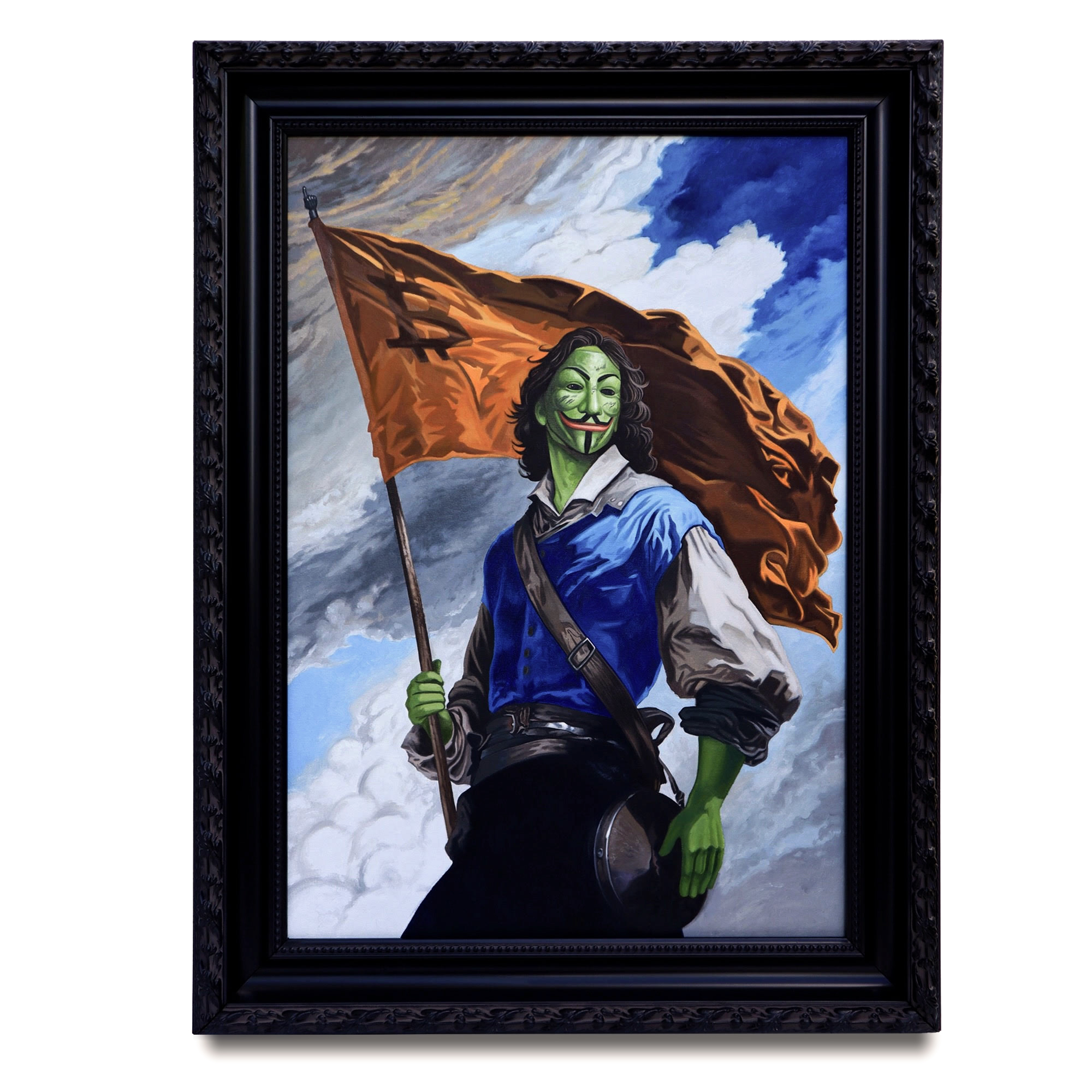
Analysis of “SMUGTRUMP”
“SMUGTRUMP” continues the memetic dialogue initiated by a 2015 tweet from Donald Trump featuring himself depicted as a Pepe. This painting captures the political oppositions and debates between Trump and Hillary Clinton, cementing political history within the context of Counterparty and current political affairs. The painting depicts Trump with green skin and a smug expression, set against a dramatic background of orange and red hues, symbolizing the heated political climate.
This work recalls the Pop Art movement, particularly the politically charged works of artists like Andy Warhol. Warhol’s portraits of political figures, such as “Vote McGovern,” used vivid colors and bold imagery to comment on the political landscape. Similarly, Pepenardo’s “SMUGTRUMP” uses the meme culture and bold visuals to capture the essence of contemporarypolitical discourse, reflecting the influence of internet culture on modern politics.


Critical Theory and Memetic Art
Richard Dawkins’ concept of the “meme” as a unit of cultural transmission is foundational. Memes, like genes, evolve and adapt, propagating through society. Pepenardo’s work exemplifies this evolutionary process, as he transforms classical images into contemporary digital artifacts. Dawkins’ theory suggests that memes compete for attention and survival in the cultural landscape, much like genes do in the biological realm. Pepenardo’s artworks, therefore, can be seen as successful memes that have adapted classical art forms to thrive in the digital age.
Jean Baudrillard’s theory of simulacra and simulation also provides a pertinent lens. Baudrillard argued that in a postmodern society, representations of reality often replace reality itself, creating a hyperreal condition where distinctions between the real and the simulated blur. The computer death chair in Pepenardo’s painting serves as a simulacrum of modern technological entrapment. It is a fictional creation that nonetheless resonates with the very real anxieties about technology’s control over our lives.
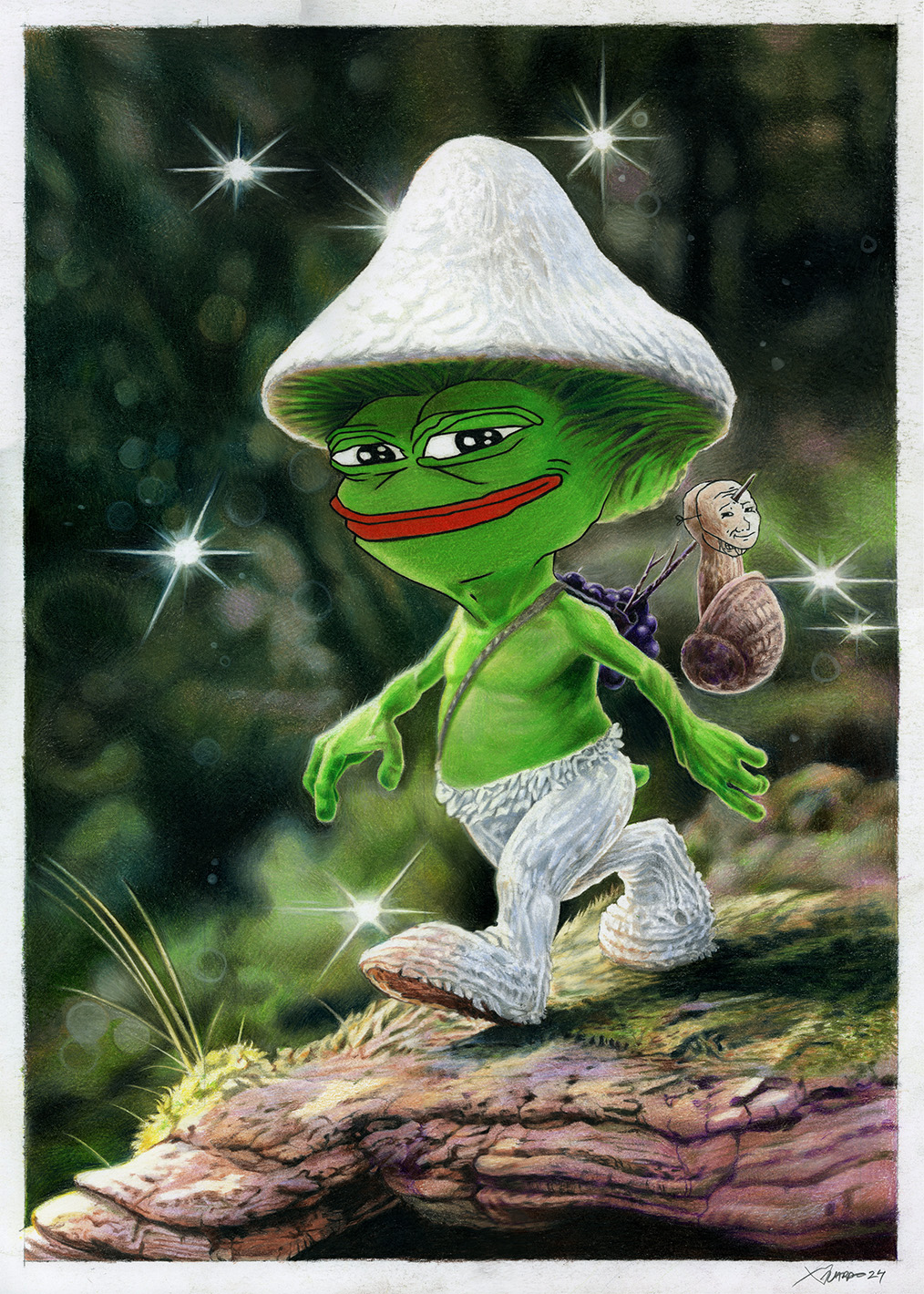
Pepenardo’s integration of classical art techniques with contemporary digital culture positions him as a pivotal figure in the evolution of memetic art. By drawing upon historical comparisons and critical theories, we can appreciate the depth and complexity of his practice. His work not only bridges the gap between traditional and digital art but also offers a profound commentary on the cultural dynamics of our time. Through Pepenardo’s lens, we are invited to reconsider the role of art in an age where memes have become a dominant form of cultural expression. His art serves as a testament to the enduring power of visual symbols and their capacity to evolve and resonate across different eras and media.
